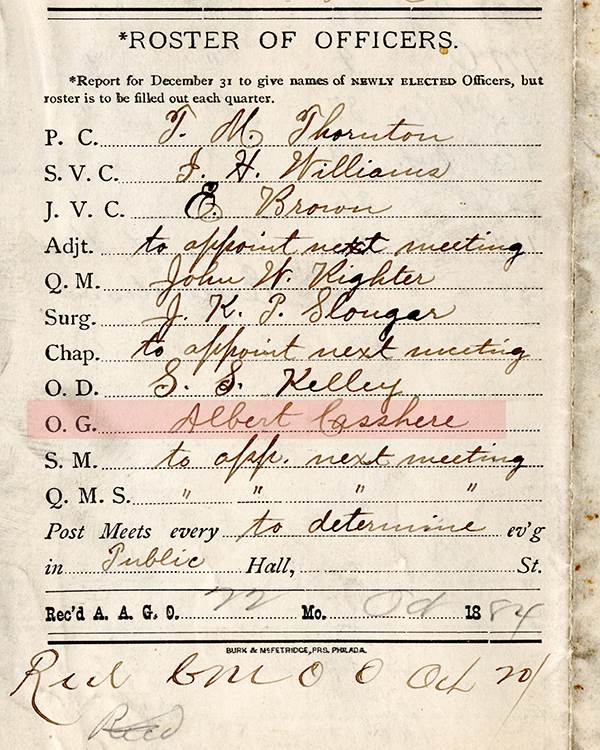By Michelle Miller
One of the joys of working with manuscripts is the fact that each collection – and really, each document – has a story to it. It represents a particular moment in the life of a particular person or group of people, and those stories and the people they’re tied to are all unique, covering a wide range of experiences.
One excellent example of a collection where you can see this is the Grand Army of the Republic (G.A.R.) records. The Abraham Lincoln Presidential Library holds records – mostly quarterly reports and charters – for the Illinois section of the GAR, a fraternal organization for Union Veterans that was founded in Springfield. These records often list the officers and arriving or departing members of each individual post. This collection is quite popular with researchers whose ancestors served in the war – connecting them to a tangible token of their family member’s service and maybe even giving previously unknown details.
Among the records for post #486 in Saunemin, Ill., one can find the name Albert D. J. Cashier. The founding post record from October 1884 lists fourteen members, and Cashier is the eighth. The record notes that he was 39 years old, born in Ireland, and worked as a laborer. He had served three years, from 1862 to 1865, as a private in Company G of the 95th Illinois Infantry. From 1884 to 1887, he served as the post’s Officer of the Guard, and he appears to have been an active member throughout his life.
 1884 document showing Albert Cashier serving as Officer of the Guard in GAR Post 486
1884 document showing Albert Cashier serving as Officer of the Guard in GAR Post 486
His name appears again in June 1911, when he briefly served as the post’s Sergeant-Major. This record also notes that he left the post in May, upon entering a veterans home in Quincy after an injury.
On its face, this story is not a particularly remarkable one. After all, millions of men lived lives such as this: joining the military, retiring to civilian life, and participating in veteran’s groups. Cashier, however, is a well-known soldier for the fact that in 1911, it became publicly known that he had been identified as female at birth.
 1911 document showing Cashier left the post to live in the state's Soldiers Home
1911 document showing Cashier left the post to live in the state's Soldiers Home
Today, it is impossible to know why he spent over forty years of his life living as Albert Cashier after the Civil War ended. Some modern scholars have posited that, although he wouldn’t have had such words to describe himself at the time, Cashier was what we would today refer to as a transgender man. Others think that perhaps he simply found it more advantageous to live life under a male identity that afforded him more opportunities.
Whatever the case, it seems that this was the name and identity by which he preferred to be known through the rest of his life, so I have chosen to refer to him accordingly.
Cashier enlisted with the Union Army at age 19. His enlistment record describes him as 5’3”, with auburn hair and light eyes and complexion. During his time with Company G, he saw action at such notable events as the siege of Vicksburg, the Battle of Brice’s Crossroads, and the Battle of Nashville. He was honorably discharged in August 1865, after the war had run its course.
He seems to have lived a quiet life after leaving the Army. He lived in northern Illinois, spending some time in Pontiac and Belvidere before settling in the village of Saunemin around 1870, where he stayed for over 40 years. He worked as a lamplighter and chauffeur, among other jobs, and appears to have been active in his small community, including in the G.A.R. He always marched in Memorial Day parades and was quite fond of wearing his Union uniform.
Though he was perceived as strange by some, he also seems to have had friends in the village. Both Army comrades and neighbors vouched for him when the revelation about his sex created a challenge to his Civil War pension.
Albert D. J. Cashier died in October 1915 due to complications from dementia. He was buried with full military honors and in the uniform which he had always worn with pride, with a small white military marker bearing his chosen name and his Civil War unit.
Whatever the case may be regarding Cashier’s identity, we do know that he was a proud soldier, who fought alongside other Illinois men. He participated in major events of the Civil War and was always proud of his service. Nearly twenty years after the war’s end, he became a member of the Saunemin G.A.R. post, and this small piece of his life was documented in records that eventually came to the ALPLM.
His story is a remarkable one, but it is also one of many stories uncovered here every day, with each turn of the page.
Michelle Miller is the ALPLM manuscripts librarian.